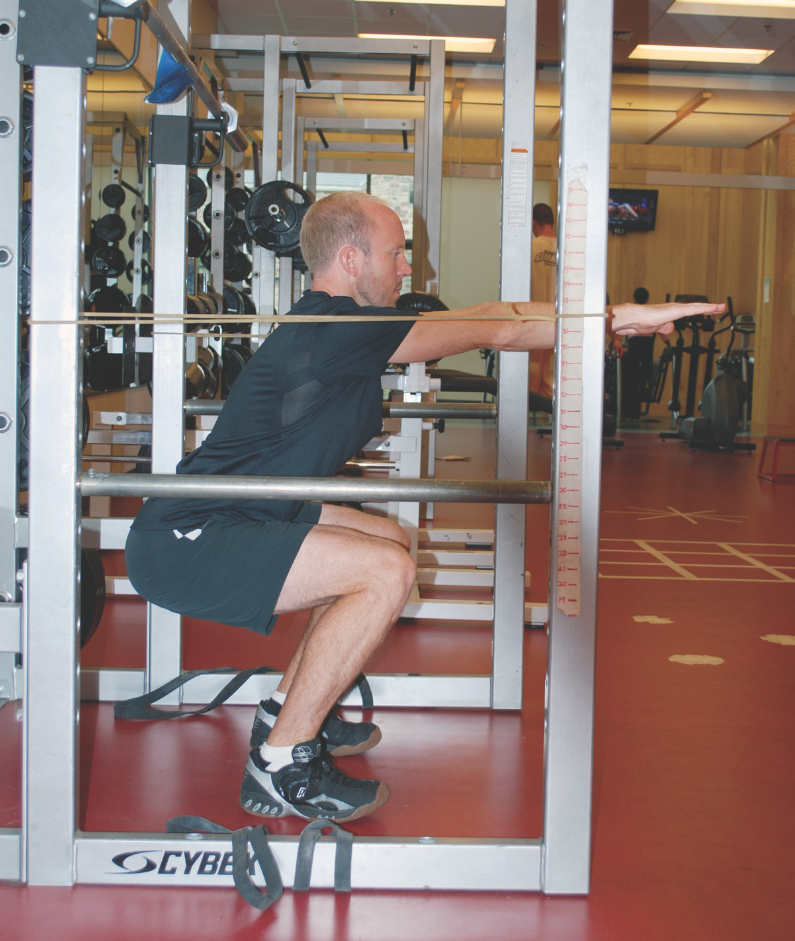By Damon Leedale-Brown, Sports Scientist & Conditioning Specialist
Last month we discussed philosophies of effective strength training techniques for squash, and highlighted the benefits of exercises performed in standing positions (i.e., body-weight squat and lunge) which require you to control movement through full range athletic positions.
This month we will expand on these exercises with a view to the development of functional lower body strength which, for a squash player, should be a key focus of any well-designed strength training program.

Body-Weight Squat
The squat is a common exercise in most athletic strength training programs and the body-weight squat is a great starting point for any athlete new to strength training. If you tried the simple squat assessment you may have already realized that this movement can tell us a lot about an individual’s flexibility in the hips, ankles and hamstrings along with general strength of the lower body.
The following are the key steps in developing a technically sound body weight squat:
- Start with arms extended in front of your body and hands at shoulder height.
- Focus on keeping your chest open by drawing back your shoulders and keeping the upper and lower back arched and tight.
- Position your feet approximately shoulder width apart with toes slightly turned out.
- As you descend into the squat, sit back into the hips with your weight through the heels, and keep hands at shoulder height.
- Descend with control until the tops of your thighs are parallel to the floor, and check that your knees stay over the toes and do not collapse inwards or spread outward.
- On the ascent focus on driving up with your chest as you drive your heels into the floor, moving the hips up and forward.
- Start by performing 2-3 sets of 10-12 body-weight squats which you could do 2-3/week.
Only when you can perform the body-weight squat with excellent technique for a set of at least 10 repetitions should you consider progressing onto using weights (i.e. bars/medicine balls).
 Single Leg Strength
Single Leg Strength
Single leg strength is essential to improving speed, balance and movement in a sport such as squash where you are constantly transferring weight from one leg to another, particularly in lunging movements. Many programs focus too much on double-leg exercises such as squats and leg presses, or other non-functional machine weight exercises such as leg extensions and curls. While squats provide a great foundation and starting point to developing lower body strength, it is important to note that single leg strength cannot be fully developed through double leg exercises.
The lunge is a fundamental movement required on the squash court in order to move with balance, control and efficiency and is a great single leg strength exercise to include in your training program. Key steps in performing the lunge are as follows:
- Start with feet together and focus on staying tall and erect through the upper body at all times throughout the movement.
- Step forward into the lunge—as a rough guide the lunge should be about as long as you are tall. Common errors in the lunge are taking too short a step which makes the movement feel very “crowded,” and becomes difficult to drop the hips into position.
- The lunge should be long enough to create a stretch in the hip flexors of the rear leg.
- The knee of the lunge leg should finish roughly above your ankle and should not be pushing beyond the toes. Essentially the hip, knee and ankle of the lunge leg should create a right angle.
- As you come out of the lunge focus on pushing from the hip of the lead leg and drive the heel into the ground as you push backwards. Avoid throwing the shoulders back to come out of the lunge.
- Start of by performing 2-3 sets of 8-10 lunges on each leg, and 2-3 times/week.
As with the body-weight squat only look to add extra weight to the lunge at a point where you can perform a set of 8-10 lunges on each leg with good technique and execution. Additional resistance could be provided in the form of a weight vest, or weight bar placed across the top of the back.
This should get you started with a couple of great exercises to develop good all round lower body and single leg strength.
Next month we will introduce other exercises to help you build a balanced strength training program for squash.





